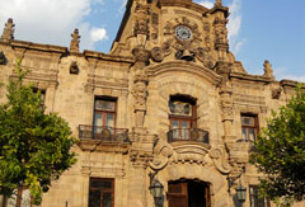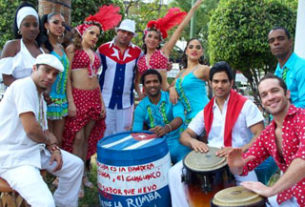Long-time travelers to Mexico will have noticed an increase in the presence of Mexican military units around the country, particularly roadblock inspection squads purportedly searching for drugs and weapons. In remote areas of the Sierra Madre it’s not uncommon to come upon small, camouflage-clad patrols bivouacked outside towns and villages. Larger troop movements in Chiapas, Guerrero, Aguascalientes, Oaxaca, Hidalgo, Puebla, and San Luis Potosí have been even more visible.
In spite of the economic crisis of 1994-95, the government paid an estimated US$2.2 billion to the U.S. for military purchases during that period, a 40% increase over 1993 expenditures. In June 1996 an active-duty army general assumed the Mexico City police chief’s post and replaced nearly a hundred high command police assignments with army officers. Meanwhile military officers have superseded civilian law enforcement heads in 21 out of Mexico’s 31 states.
There’s a threefold answer to the question everyone’s asking: Where did the men in green come from? The first explanation has to do with marijuana, heroin, cocaine, and amphetamine trafficking, which has reached ever higher levels in Mexico over the last 20 years. Under pressure from the U.S. and other major drug-consuming countries, the Mexican government is making a very serious effort to tackle the problem. Several major figures in narco cartels have been captured and prosecuted. In 1995-96 Mexican officials reported two consecutive record years in eradicating nearly 20,000 acres of marijuana and poppy crop–much of this owing to military search-and-destroy missions in the mountainous areas where these crops are grown.
Whether arrests and crop destruction will have any ultimate effect on drug trafficking in a world where demand for chemical sedation/stimulation appears insatiable remains a topic of heated debate. American complicity in the trafficking of such drugs is unquestionable. Whether or not it’s true that an estimated 75% of the cocaine, 70% of the amphetamines, and 40% of the heroin on American streets has traveled through Mexico, it’s undeniably true that 100% of all these substances must travel through the U.S. to reach their markets; hence to blame Mexico for lack of narco enforcement when the U.S. can claim even less success in the war on drugs is viewed by many in Mexico as the height of American hypocrisy.
The second explanation involves the very complicated issue of corruption in Mexican law enforcement. While petty bribery in Mexico seems to be in gradual decline, higher-level corruption-especially in the drug arena-has probably never been higher. In many cases it can be said that local law enforcement has no choice but to cooperate with local narcotraficantes–it’s either “get rich or get dead.” In response to this dilemma, Mexico City has stationed four 30-agent federal task forces in Ciudad. Juárez, Monterrey, and Tijuana. These units have been compared to the American “Untouchables”–straight, incorruptible–who pursued U.S. mobsters in the 1930s. Of course in current Mexican popular culture–in movies, in musical ballads–it’s usually the narcotraficante, not the fed, who’s the hero. Drug czars spend an estimated US$500 million a year in bribery of Mexican officials, while the total annual federal budget for the Mexican attorney general’s office (to fight all crimes, not just drug manufacture/trafficking) totaled just US$200 million in 1996.
Is the military incorruptible? General Jesús Gutiérrez Rebollo, head of the National Institute to Combat Drugs, an elite agency established in 1993 to take over anti-drug operations from the police, was fired from his post in February 1996 for taking huge bribes from Amado Carrillo Fuentes, godfather of the country’s largest cocaine and heroin trafficking cartel. It was the first time in Mexican history a high-ranking military officer was charged in connection with drug trafficking. Though the scandal was a crushing blow to the country’s image, to its credit the Zedillo government didn’t sweep it under the carpet but instead took action immediately. Another general has taken Rebollo’s place and government officials apparently remain confident in the military approach.
The third explanation for Mexico’s growing militarization is perhaps the most ominous of all for Mexico though it probably affects foreign visitors the least. Growing disaffection with the federal government, especially in poor, rural areas of southern Mexico, has re-introduced the specter of armed rebellion to Mexico for the first time since the turbulent ’60s and ’70s. On New Year’s Day 1995 several towns in Chiapas were seized by the Zapatista National Liberation Army (Ejército Zapatista de Liberación Nacional , or EZLN), a guerrilla group previously unknown to the public. The masked, uniformed, armed group of several hundred, under the leadership of articulate pipe-smoking poet “Subcommandante Marcos” (later revealed to be Rafael Sebastián Guillén Vicente, a former university lecturer from Tampico) announced a long list of demands which focused on reforms in health care, land distribution, and education for Amerindian minorities.
A 12-day skirmish between the Zapatistas and government troops in Chiapas left an estimated 145 dead (according to most sources, though the true number will probably never be known) and hundreds incarcerated. Human rights groups reported incidents of torture and forced confessions during and after arrests. A cease-fire, followed by peace talks mediated by the Catholic Church, lasted for a year until the Zapatistas declared an end to the cease-fire in early 1996. No further armed conflict with the EZLN, however, has since been reported.
In June 1996, on the anniversary of a massacre of 17 peasants by state police in Aguas Blancas, Guerrero, yet another armed insurgent group made its debut. Calling themselves the Popular Revolutionary Army (Ejércicio Popular Revolucionario, or EPR), the AK-47-toting guerrillas recited a manifesto which stated its purpose was “to overthrow the anti-popular, anti-democratic, demagogic, and illegitimate government which panders to national and foreign capital interests.” Two months later the group targeted police stations, government offices, and military installations in simultaneously mounted attacks in four states (Oaxaca, Guerrero, Chiapas, and Mexico), leaving at least 13 dead. The attacks appear to have been a retort to Mexican officials who claimed the group didn’t actually exist. Even leftist PRD leader Cuautémoc Cárdenas denounced the group as a “pantomime” before the attacks.
That same month saw the appearance of yet another masked group called the Democratic Popular Revolutionary Party (Partido Democrático Popular Revolucionario or PDPR), which claimed they represented 14 different guerrilla groups–including the EPR. Other groups who have made recent public pronouncements include the People’s Revolutionary Insurgent Army (ERIP) and the Armed Front for the Liberation of the Marginalized People of Guerrero (FALPMG). All in all, insurgency experts believe there may be as many as eight different armed rebel groups operating in as many states throughout Mexico. Guerrero, a state named for Vicente Guerrero, who led a guerrilla struggle against the Spanish from the state’s rugged sierra, has by far the highest proportion of insurgent activity. In terms of raw numbers, there are probably fewer than 1,500 armed rebels in the entire country, hardly enough to topple the government through direct confrontation but sufficient to bleed government defense budgets and create plenty of unfavorable international publicity.
Thus far these armed groups have refrained from harming or threatening tourists. The EPR has announced it may focus future assaults on tourist resort areas, which explains the recent presence of military squadrons on the outskirts of Acapulco, Cancún, Huatulco, Ixtapa, and Los Cabos (San José del Cabo and Cabo San Lucas).
Unlike their checkpoint counterparts, these special units carried out no searches on passing vehicles. Instead, according to local law enforcement officials we interviewed, the units were stationed “on call” in case of insurgent terrorism. For now rebel targets clearly appear to be limited to military and police installations rather than civilian businesses, residents or visitors. Hence the risk of traveling in these areas appears to be nearly nil as far as it relates to potential rebel activity. La Realidad, a village headquarters for the Zapatistas in Chiapas, has very nearly become a tourist attraction in itself since 1995.
For the Mexican public at large, the currently increasing military presence invokes memories of the 1968 Olympics when the Mexican army was called out to quash student unrest in Mexico City. The movement peaked on Oct. 2, when the army was ordered to clear demonstrators from Plaza Tlatelolco. Apparently under government sanction, soldiers opened fire on demonstrators with automatic weapons. Thirty-two student deaths were later officially acknowledged, though other estimates ran as high as 200 to 300. Over a thousand students were jailed, and the assault was considered to have effectively broken the back of Mexico’s student protest movement at the time.
Where current trends in the “greening” of Mexico will lead is anyone’s guess. Although troop size has grown 15% since 1994, and the military budget continues to rise at a rate of about 16% per annum, Mexico still has the lowest per capita military budget in Latin America. As Mexican novelist and insurgency expert Carlos Montemayor points out, it’s “only the final phase of a long process of social violence caused by hunger, impoverishment, desperation, and repression.” He and other observers see Mexican insurgent movements such as these as typical responses to authoritarianism, responses which will only diminish in proportion to the expanding democratization of the country.
–excerpted by permission from Mexico Handbook, available from Moon Travel Handbooks (https://www.moon.com)


